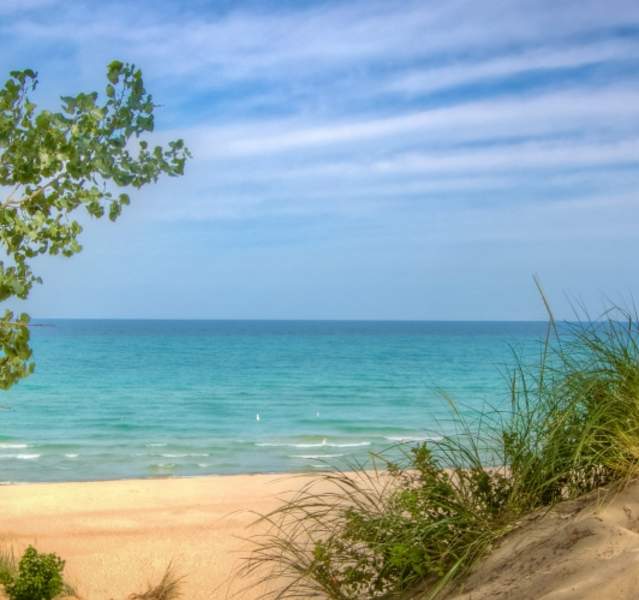May Wildflowers in the Indiana Dunes
May is here! Time to head outdoors to see all of the amazing wildflowers that April showers have brought to the Indiana Dunes!
The Indiana Dunes Flower Quest continues this May as new blossoms join the lovely spring ephemerals popping up throughout our region. How many can you spot before they disappear for another year?
Visit the Indiana Dunes Flower Quest homepage for important information, and then grab your camera and hit the trails! Be sure to share pictures of the treasures you spy at #DunesFlowerQuest.
![]()
Be sure to tag @indianadunes and use #dunesflowerquest.
Need some help identifying your discoveries? Try identify.plantnet.org.

Bird-foot Violet
Did You Know?:
This lovely violet-blue flower has five petals: often two of the upper petals will be a considerably darker shade of purple. The lower petal is white, with fine violet lines. The petals surround a golden orange stamen in the center of the flower. The violet gets its name from the distinctive shape of its leaves, which are wider at the end than at the base, reminiscent of, you guessed it, a bird foot! This flower actually expels its seeds, and a gel that surrounds the seeds attracts ants, which help disperse them.
Reference the Quest Map to help guide you to this flower.
Blackberry
Did You Know?:
Don’t let the name fool you: this shrub is actually part of the rose family! Each plant will have up to twelve white flowers. The petals—which often look wrinkled!—surround a cluster of yellow stamens in the center. After the flowers are done blooming, the plant later grows a drupe, a seedy “fruit” that turns almost black.
Reference the Quest Map to help guide you to this flower.
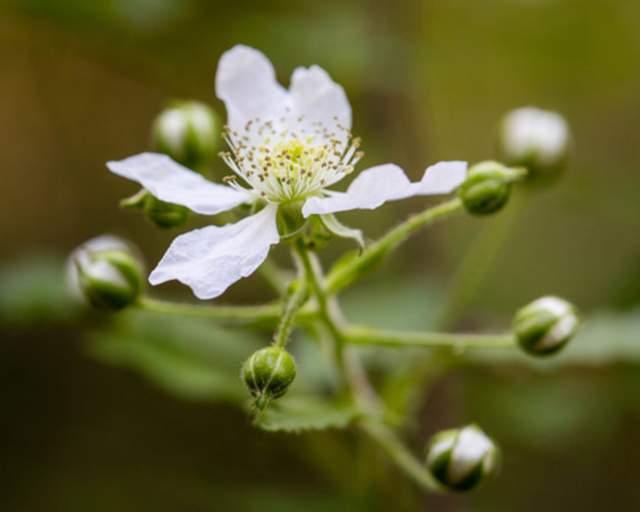

Cat's Foot
Fun Facts:
The tight cluster of fuzzy white or pink flowers on this plant are said to resemble a cat’s paw. In fact, they are also called pussy toes! But these flowers aren’t just the cat’s meow: another common name is “Mountain Everlasting.” These lovely plants stay close to the ground, only growing 2-3” tall, but a single plant can spread up to 18 inches.
Reference the Quest Map to help guide you to this flower.
Common Lousewort
Did You Know?:
These plants can grow up to two feet tall, and their leaves look like those of miniature ferns. The flowers themselves grow in a spike at the top of the plant, with pale yellow petals. The name is unappealing, but undeserved: farmers thought that animals that grazed on the plants got lice because of it—they didn’t—but the reputation stuck!
Reference the Quest Map to help guide you to this flower.


Dwarf Ginseng
Did You Know?:
This lovely wildflower has a pale green stem that leads to a cluster of tiny white flowers, each flower extending from a single point in the center. After the plant finishes flowering, the white petals are replaced by clusters of yellow berries.
Reference the Quest Map to help guide you to this flower.
Iris Virginica
Did You Know?:
These irises may remind you of flowers in your own garden, but this particular species thrives in wetland areas like those found in the Indiana Dunes. They grow two to three feet tall, and they have long, sword-shaped leaves surrounding hairy stems and, you guessed it, beautiful purple and dark blue flowers.
Reference the Quest Map to help guide you to this flower.


Jack in the Pulpit
Did You Know?:
This unique plant has two to three stems, growing up to 2-3 feet high with glossy leaves. The flower that gives it its name grows on its own stem, and has a “hooded” green petal with brown stripes that covers a spadix–the “jack”–with tiny green or yellow flowers. These amazing plants can live up to twenty-five years, and can even change their sex depending on the growing conditions!
Reference the Quest Map to help guide you to this flower.
John's Cabbage
Did You Know?:
This plant can spread easily across the ground in shaded wooded areas, and has large, bright green leaves that contrast with beautiful white flowers growing in round clusters. It’s also known as Virginia waterleaf, because the markings on the leaves look like water spots!
Reference the Quest Map to help guide you to this flower.


Lupine
Did You Know?:
These beautiful plants feature a cluster of leaves glowing close to the ground with a flowering stem stretching up to two and a half feet tall! The stem is covered with a number of purple or pale blue flowers. After about a month, these lovely blossoms are replaced by seed pods, and the lupine can actually eject them several feet away from the plant!
Reference the Quest Map to help guide you to this flower.
Nodding Wakerobin
Did You Know?:
There are a number of beautiful trilliums in the Indiana Dunes, but only this species looks like it’s falling asleep! These lovely creamy white flowers sometimes bend so low on their stems that they tuck beneath their broad green leaves.
Reference the Quest Map to help guide you to this flower.

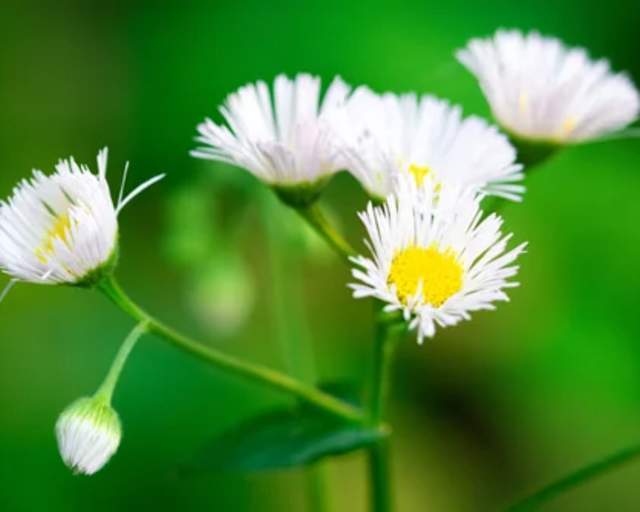
Prairie Fleabane
Did You Know?:
Prairie fleabane is a member of the asters. It’s also called the daisy fleabane, and when you see it, you can guess why! But what looks like one flower with a yellow center and white petals is actually many flowers clustered together. And yes, once upon a time people believed these flowers kept fleas away. And no, they don’t!
Reference the Quest Map to help guide you to this flower.
Ragwort
Did You Know?:
Bees, flies, and butterflies love these yellow flowers, but they are toxic to grazing animals, making them rather unpopular with most, including deer! It got its name from its “ragged” leaves combined with an Old English word for “plant.”
Reference the Quest Map to help guide you to this flower.

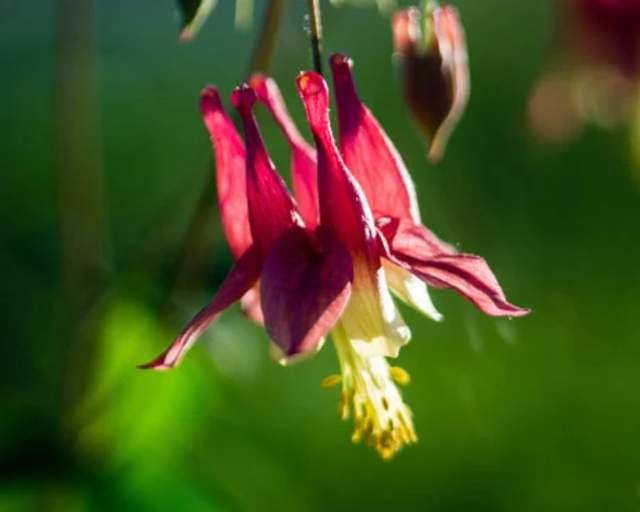
Red Columbine
Did You Know?:
These lovely red and yellow drooping flowers are favorites of hummingbirds. Some insects love them, too, but when they can’t reach inside the petals, they cut tiny holes in the base! You will often see several blossoms on a single plant, looking a little like a cluster of small torches!
Reference the Quest Map to help guide you to this flower.
Starry False Solomon's Seal
Did You Know?:
Look for the crooked, leaning stem leading to a lovely cluster of small white flowers. Over time, those bright white flowers will be replaced by red berries. A number of birds and animals love these berries, and help spread the seeds.
Reference the Quest Map to help guide you to this flower.

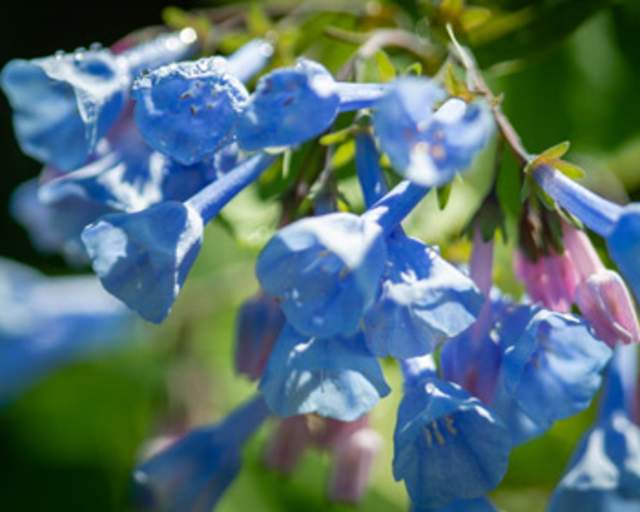
Virginia Bluebell
Did You Know?:
As the name suggests, this flower features clusters of beautiful blue blossoms, which also shade to purple and even pink over time. Thomas Jefferson grew them at Monticello, and for a time some called these flowers “Jefferson’s blue funnel flowers”!
Reference the Quest Map to help guide you to this flower.
Wild Strawberry
Did You Know?:
Before you see the fruit, you will see the lovely white petals of this low-growing wildflower. Of course, as much as people love strawberries, insects, birds, and animals love them even more. While the list of creatures that feed on these plants is long, they help to spread the seeds!
Reference the Quest Map to help guide you to this flower.

A Note on Invasive Wildflowers
The Indiana Dunes are home to so many beautiful wildflowers. Unfortunately, not all of them belong here. Over the years, non-native species have taken root in the region, crowding out native species that are crucial for supporting fragile ecosystems. The parks, non-profit organizations, and volunteers work diligently to restore these areas.
If you spot an invasive species, please leave it be: it takes careful oversight to remove these plants without damaging the area, and poison ivy, ticks, and sometimes even toxins from the plants themselves can be a hazard.

Dame's Violet
These lovely flowers were brought over from Europe as ornamental plants, and, as plants often do, escaped into the wild. While they look like a native plant, prairie phlox, the dame’s violet only has four petals instead of five. Several clusters of flowers will grow from the hairy stem.

Lily of the Valley
The attractive bell-shaped flowers of this non-native plant made it a sought-after addition to gardens. It proved to be as hardy as it is lovely, and it has spread to a number of wild habitats like those found in the Indiana Dunes. Its fragrance makes it valuable for the perfume industry, but it seems to offer little to most pollinators, and its toxicity keeps animals away, as well.

Yellow Iris
With its tall stems and sword-shaped leaves, the yellow iris is easily recognizable, and is a common part of many gardens. However, it has spread to more natural habitats including marshes and wetlands and can now be found in every state. Because it can be so difficult to control, some states have banned this flower.
Jack or Jill?
Botanist, Nathanael Pilla talking about a vey interesting woodland wildflower, Arisaema triphyllum (Jack in the Pulpit).
More Things to See & Do
Outdoor Adventures
Shaped by nature, made for adventure. In the Indiana Dunes, it’s all about fun times and tan lines—from…
Dunes Deals
Shake off the sand south of the Indiana Dunes! Dig up real savings with Indiana Dunes Deals and make the most of…
Indiana Dunes Shop
Don’t just experience the Indiana Dunes; take it home with you. Find your new favorite T-shirt, hoodie, or…
Pet Friendly
There’s a reason Indiana Dunes National Park was named the #1 pet-friendly attraction in the state of Indiana…
Arts & Entertainment
It’s not all sand-fringed lakes and epic sunsets. Here, you’ll find a vibrant arts scene stoked by a…
Volunteer
Be the Change — Volunteer! Get more involved with the Indiana Dunes!
The story of the monarch butterfly is one of incredible transformation and epic travel. We are also part of this adventure, and each of us can play a key role in the survival of the monarch…
Plant Your Own Monarch Garden


15% Off
Applies to native plants and monarch butterfly plants. Valid on regularly priced plants, shrubs, and trees only. Show this coupon at the register.
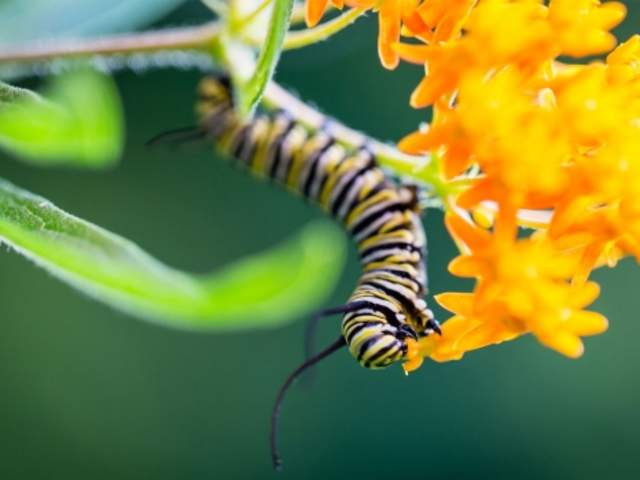

15% Off
Applies to native plants and monarch butterfly plants. Valid on regularly priced plants, shrubs, and trees only. Show this coupon at the register.
Tales from the Dunes
Indiana Dunes Blog
Indiana Dunes National Park is 5th in the nation for biodiversity. That’s more than Yellowstone, Grand Teton, and the Everglades. Read more about monarchs and other diverse flora and fauna.
Book a Place to Stay
Bed & Breakfasts
Feel like family with intimate accommodations that range from nature-inspired retreats in the woods…
Hotels & Inns
A convenient stay located near downtown? What about a country retreat heaped in Old World charm? Or…
Spotlight on Wetlands and the Virginia Rail
- 5 minute read
Spring has sprung and that means our Kankakee Sands wetlands are teeming with activity. The Kankakee Sands Bird…
Why We Should Try to Appreciate Spiders
- 5 minute read
Did you know that the first week of April is National Be Kind to Spiders Week? To be kind to spiders (that is, to…
Interesting Facts About the Indiana Dunes
- 6 minute read
There's more to the Indiana Dunes than warm sand, blue water, and miles of hiking trails. For example, as of…
Walking in a Winter Wonderland
- 5 minute read
It’s December, and I find myself singing along to all the holiday songs on the radio and playing in the…
Hitchhiking Seeds: How Plants Travel
- 4 minute read
It’s the fall seed harvest time of the year. Most days, after spending time in the prairie harvesting native…
